Endpoint Security Statistics By Market Size, Types, Revenue, Region, Threat Protection, Industry and Trends 2025
Updated · Sep 09, 2025
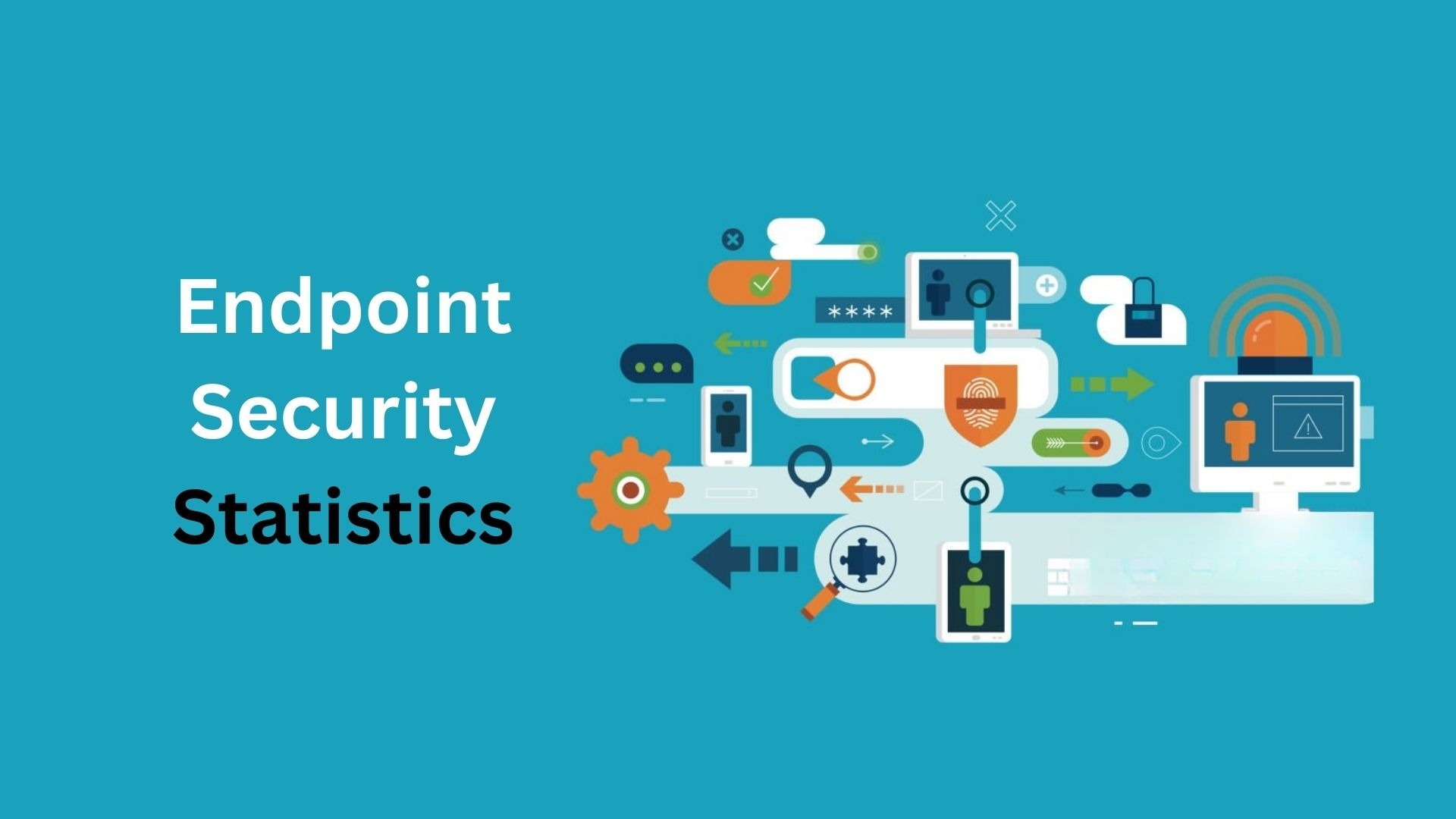
Table of Contents
- Introduction
- Editor’s Choice
- Endpoint Security Market Size Statistics
- Endpoint Security Statistics by Types of Cyberattacks
- Current Endpoint Security Trends Statistics
- Endpoint Security Statistics by Revenue Comparison of Top 5 Countries
- By Region-Wise Revenue Comparison
- BYOD and Endpoint Security Risks
- Endpoints Unknown Risks Statistics of Shadow IT
- Endpoint Security Risks Caused by Employees
- Endpoint Threat Protection Market Statistics
- Endpoint Security Threats Statistics
- Endpoint Protection Technology Statistics
- Endpoint Protection Customers by Employee Size, 2025
- By Country
- By Industry
- Cost of Insecure Endpoint Statistics
- Conclusion
Introduction
Endpoint Security Statistics: Endpoint security, also called endpoint protection, protects computer networks from risks that come through connected devices such as laptops, tablets, and smartphones. When these devices connect to a company network, they can introduce vulnerabilities that need to be managed and secured.
Endpoint security ensures they follow security rules and standards, helping prevent attacks and keeping the network safe from potential risks. This article presents key statistics on endpoint security, highlighting trends, risks, and the measures organizations take to safeguard their networks.
Editor’s Choice
- According to the Statista report analysis, the global market of Endpoint Security is expected to generate about USD 15.41 billion in revenue by the end of 2025.
- From 2025 to 2030, it is projected to grow at a CAGR of 10.04%, reaching around USD 24.85 billion by 2030.
- On average, spending per employee is estimated at USD 4.11 in 2025.
- Among all regions, the United States is forecast to lead with the highest revenue of USD 6.2 billion in 2025.
- The top-most threat of Endpoint Security is credential theft, which involves almost 56% of cases, while phishing and social engineering come next at 48%.
- A scoop.market.us report states that the top concern is lack of physical security in the workspace (47%), followed by malware infections (32%).
- A survey of Guardz shows that 92% of remote workers use their own tablets or smartphones for tasks, and 46% have stored work files on them.
- 71% of HR professionals had at least one departing employee fail to return company devices like laptops or smartphones.
- The market.biz report analysis states that Endpoint malware detections rose by 300% in Q3 2024.
- 6sense.com report analysis 2025 further states that the endpoint protection market is led by CrowdStrike, holding an estimated 20.65% share with around 6,403 customers.
- In contrast, 63% of companies declared that they are not able to monitor endpoints outside their networks.
Endpoint Security Market Size Statistics
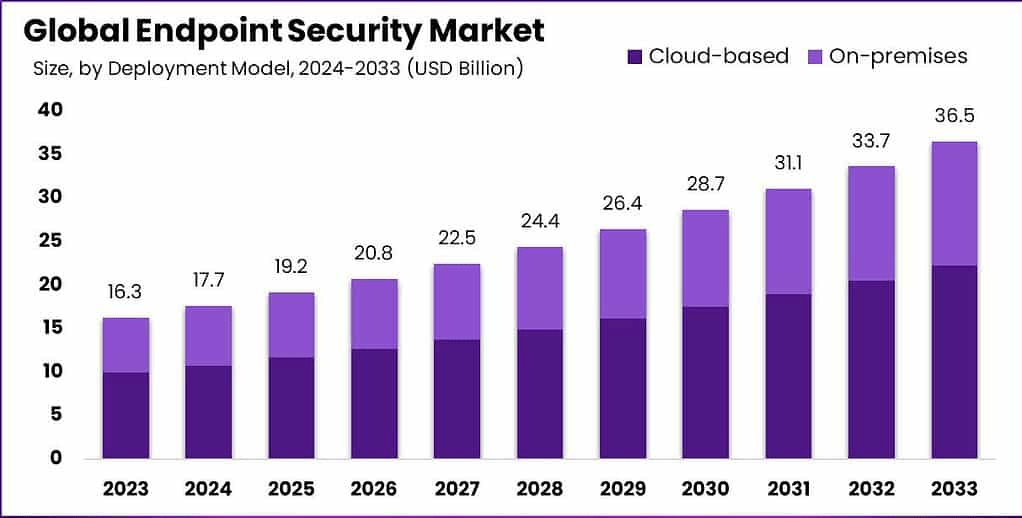
- The global endpoint security market will reach around USD 19.2 billion by 2025.
- The growth rate of the market will reach 8.4% CAGR from 2024 to 2033, resulting in USD 36.5 billion by 2033.
- Furthermore, estimated revenue in the coming years is going to reach USD 20.8 billion (2026), USD 22.5 billion (2027), USD 24.4 billion (2028), USD 26.4 billion (2029), USD 28.7 billion (2030), USD 31.1 billion (2031), and USD 33.7 billion (2032).
Endpoint Security Statistics by Types of Cyberattacks
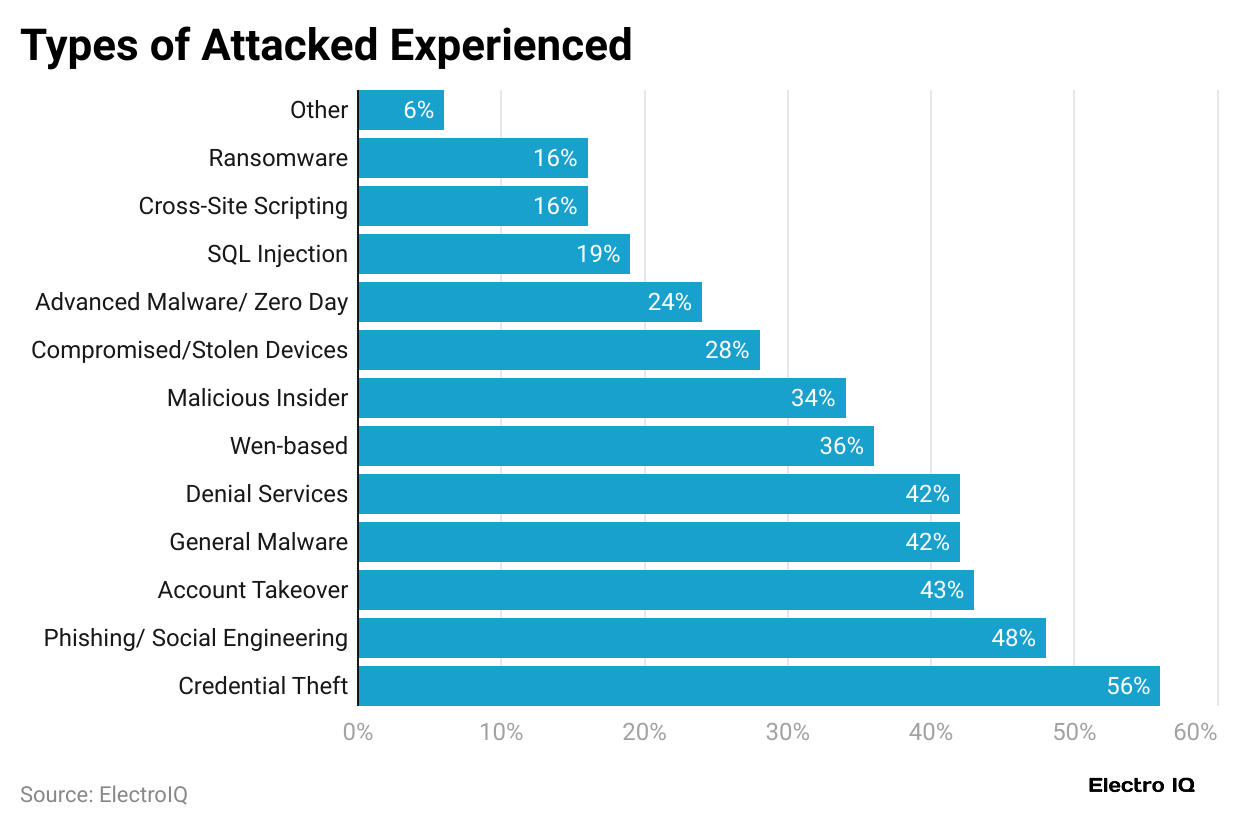
- The top-most threat of Endpoint Security is credential theft, which involves almost 56% of cases, while phishing and social engineering come next at 48%.
- Account takeovers affect 43%, while both general malware and denial-of-service attacks impact 42%, making them other major risks to watch out for.
- Other frequent issues include web-based attacks (36%), insider threats (34%), and compromised or stolen devices (28%).
- Meanwhile, advanced malware or zero-day exploits account for 24%, SQL injection for 19%, and both ransomware and cross-site scripting for 16% each.
- Less common but still significant are attacks classified as “other,” at 6%.
Current Endpoint Security Trends Statistics
- A scoop.market.us report states that the top concern is lack of physical security in the workspace (47%), followed by malware infections (32%), remote device takeovers for data theft (24%), securing external communications (23%), and network safety (20%).
- Other concerns include devices being used for unauthorized access (17%), phishing and social engineering attacks (15%), lost or stolen devices (12%), and securing external access to internal resources (8%).
- Since the pandemic, 51% of companies reported malware bypassing intrusion detection, and 49% saw malware evade antivirus systems.
Endpoint Security Statistics by Revenue Comparison of Top 5 Countries
- In the United States, the endpoint security market size is expected to generate about USD 6.24 billion in 2025.
- From 2025 to 2030, it is predicted to grow at a 9.60% annual rate, resulting in USD 9.86 billion by 2030.
- Companies are likely to spend around USD 35.85 per employee on endpoint security in 2025.
Furthermore, other countries’ revenue analysis is stated in the table below:
| Country | Revenue (USD) | CAGR | Spend per Employee (USD) | |
| 2025 | 2030 | |||
| United Kingdom | 1.18 billion | 1.98 billion | 10.87% |
32.86 |
|
Japan |
970.44 million | 1.52 billion | 9.38% | 13.91 |
| China | 777.13 million | 1.34 billion | 11.48% |
0.99 |
|
Germany |
709.63 million | 1.10 billion | 9.21% |
15.57 |
By Region-Wise Revenue Comparison
| Region | Revenue (USD) | CAGR | Spend per Employee (USD) | |
| 2025 | 2030 | |||
| Africa | 183.29 million | 318.02 million | 11.65% | 0.35 |
| Americas | 7.26 billion | 11.55 billion | 9.73% | 14.22 |
| Asia | 3.10 billion | 5.22 billion | 11.01% | 1.37 |
| Australia & Oceania | 453.78 million | 728.88 million | 9.94% | 20.42 |
| Caribbean | 29.47 million | 47.71 million | 10.12% | 1.54 |
| Central & Western Europe | 3.08 billion | 4.95 billion | 9.94% | 17.63 |
| Central Africa | 15.90 million | 25.53 million | 9.94% | 0.41 |
| Central America | 26.76 million | 46.61 million | 11.74% | 1.13 |
| Central Asia | 37.19 million | 69.69 million | 13.39% | 1.14 |
| Eastern Africa | 30.73 million | 58.86 million | 13.88% | 0.13 |
| Eastern Asia | 1.34 billion | 2.11 billion | 9.43% | 1.47 |
| Eastern Europe | 399.68 million | 609.23 million | 8.80% | 3.40 |
| Europe | 4.41 billion | 7.03 billion | 9.77% | 10.52 |
| North America | 6.83 billion | 10.84 billion | 9.69% | 26.41 |
| Northern Africa | 35.05 million | 62.80 million | 12.37% | 0.44 |
| Northern Europe | 273.93 million | 439.25 million | 9.90% | 14.56 |
| South America | 376.82 million | 618.47 million | 10.42% | 1.80 |
| Southeast Asia | 405.48 million | 721.23 million | 12.21% | 1.15 |
| Southern Africa | 71.95 million | 114.51 million | 9.74% | 2.39 |
| Southern Asia | 287.84 million | 574.12 million | 14.81% | 0.32 |
| Southern Europe | 655.01 million | 1.03 billion | 9.52% | 6.07 |
| Western Africa | 29.65 million | 56.32 million | 13.69% | 0.20 |
| Western Asia | 248.98 million | 415 million | 10.76% | 2.94 |
BYOD and Endpoint Security Risks
- A survey of Guardz shows that 92% of remote workers use their own tablets or smartphones for tasks, and 46% have stored work files on them.
- Around 97% of executives log into work accounts from personal devices, while 80% send work-related messages this way.
- Microsoft found that 80% to 90% of ransomware attacks come from unmanaged devices.
- Risks increase as 36% delay security updates, 71% store work passwords on phones, and 38% report no clear BYOD policies.
- In addition, 67% of enterprises use multiple vendors for device security, whereas only 42% can proactively track sensitive data on employee devices.
Endpoints Unknown Risks Statistics of Shadow IT
- Shadow IT is a growing concern, accounting for 30% to 40% of IT spending in large firms, with 80% of employees using it.
- IBM says 76% of SMBs see shadow IT as a security threat, and Capterra adds that 58% have faced high-impact cases without IT’s knowledge.
- CIO found companies think they use 37 apps, but the real number is 625.
- Remote work pushed usage up 59% (Keepnet), and 32% of remote staff use unapproved apps (Infosecurity).
- According to The Shadow IT Report, 47% of companies let employees access resources on unmanaged devices.
- Business Insider notes that 70% of workers using ChatGPT keep it hidden from their employers.
- By 2027, Gartner predicts 75% of workers will act outside IT visibility.
Endpoint Security Risks Caused by Employees
- A report from guardz.com shows that 71% of HR professionals had at least one departing employee fail to return company devices like laptops or smartphones.
- Around 65% of workers admit to bypassing security rules to stay productive, while more than 90% of lost or stolen devices cause data breaches.
- At-home workers are not immune, with 13% falling for phishing attempts.
- Studies reveal that 63% of businesses may still have ex-employees with data access, while 62% of staff move company IP to personal devices.
- Additionally, 59% of stolen equipment contained sensitive data, and only 55% were fully locked out.
Endpoint Threat Protection Market Statistics
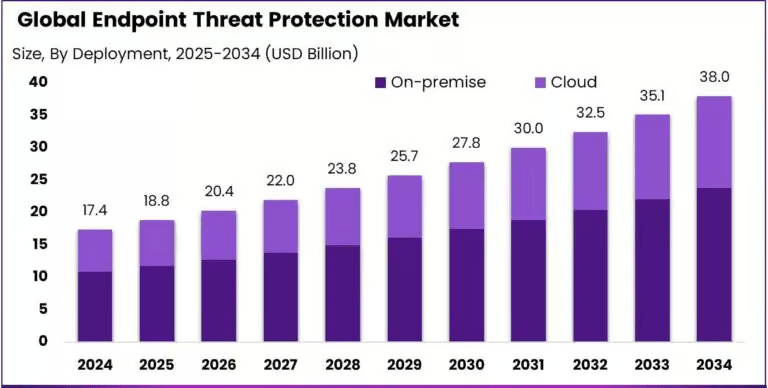
- The global endpoint threat protection market is projected to grow from USD 18.8 billion by 2025 to nearly USD 38 billion by 2034, with an expected CAGR of 8.10% between 2025 and 2034.
- In 2024, solutions made up the largest share of the market, contributing more than 67.3%.
- On-premise deployment also led the way, accounting for over 62.8% of the market.
- Among end-users, large enterprises dominated with more than 71.3% share.
- The government and defence sector also played an important role, holding over 26.7% of the market in 2024.
- Regionally, North America was the top contributor, securing more than 37.4% of the global market and generating about USD 6.5 billion in revenue.
- Within North America, the U.S. market stood out with a valuation of USD 5.83 billion in the same period and is forecasted to grow at a strong CAGR of 15.6%.
Endpoint Security Threats Statistics
- The market.biz report analysis states that Endpoint malware detections rose by 300% in Q3 2024.
- In the same period, Twilio faced a data breach that exposed 33 million Authy user phone numbers due to a flaw in an unauthenticated API endpoint.
- About 54% of security experts said more than 20% of their company’s endpoints are still unmanaged, creating major security gaps.
- Verizon’s Mobile Security Index reported that 90% of cyberattacks and 70% of data breaches start from compromised endpoint devices.
- A survey revealed that 67% of Managed Service Providers (MSPs) were hit by AI-powered attacks in the past year.
Endpoint Protection Technology Statistics
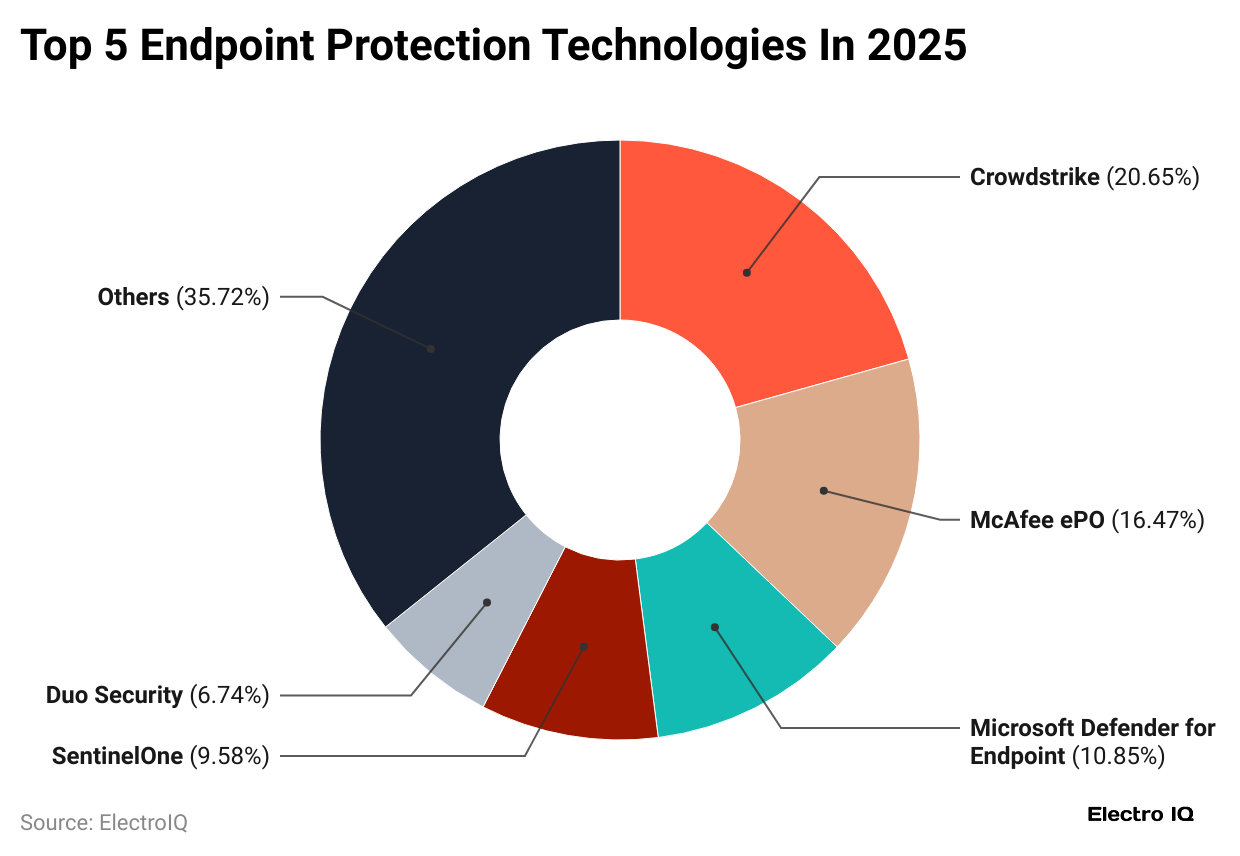
- 6sense.com report analysis in 2025 further states that the endpoint protection market is led by CrowdStrike, holding an estimated 20.65% share with around 6,403 customers.
- McAfee ePO follows with 16.47% and 5,106 customers, while Microsoft Defender for Endpoint accounts for 10.85% and serves 3,364 organisations.
- SentinelOne secures 9.58% of the market with 2,969 customers, and Duo Security holds 6.74% with 2,089 customers.
- The remaining providers, grouped under “Others,” make up 35.72% of the market, representing 11,076 customers.
Endpoint Protection Customers by Employee Size, 2025
| Number of Companies | Employee Size |
| 6,072 | 1,000 to 4,999 |
| 5,888 | 10,000+ |
| 5,157 | 100 to 249 |
| 3,320 | 20 to 49 |
| 3,167 | 250 to 499 |
By Country
- As of 2025, companies using Endpoint Protection technology software are mainly from the United States, with 15,951 (63.75%), the United Kingdom, with 2,361 (9.44%), and India with 1,566 (6.26%) customers, respectively, as mentioned in the reports of 6sense.
- Furthermore, other countries’ endpoint protection customers are followed by Canada (1,308), Australia (1,023), Brazil (834), and France (708).
By Industry
- The main industries using endpoint protection are managed services with 1,359 customers, cloud services with 1,308 customers, and cybersecurity with 1,299 customers.
- Other sectors also show strong adoption, including data analytics with 774 customers, consulting with 756 customers, and digital transformation with 747 customers.
- Meanwhile, software development has 656 customers, reflecting steady but smaller demand compared to other industries.
Cost of Insecure Endpoint Statistics
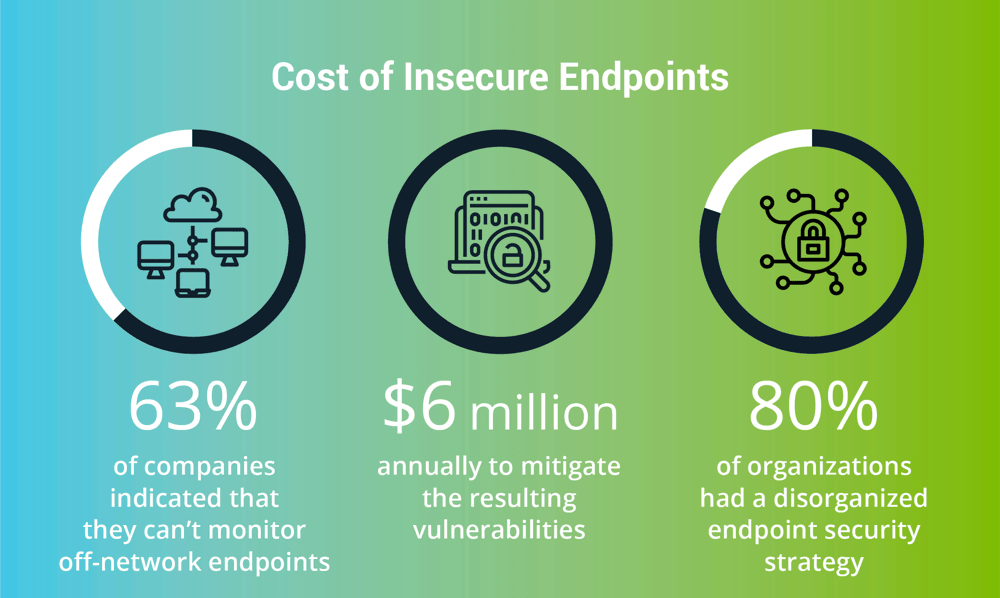
- Around 63% of companies admit they are unable to monitor endpoints outside their network, leaving critical gaps in protection.
- On average, organisations spend nearly USD 6 million each year to address vulnerabilities caused by these weaknesses.
- Additionally, about 80% of organisations report having a poorly structured or disorganised endpoint security strategy.
Conclusion
After finishing the article on Endpoint Security Statistics, it can be concluded that endpoint security is an important part of cybersecurity, as many devices like laptops, smartphones, and desktops are connected to different networks of various companies. All the above statistical analyses revealed a rise in malware, higher costs from data breaches, and growing AI-driven attacks, all of which highlight the urgent need for stronger protection.
Using tools that prevent threats, detect issues, and respond quickly helps companies lower risks and improve safety. Since cyber threats keep changing, organisations must build clear and organised endpoint security plans to safeguard their data, daily operations, and long-term growth.
Sources
FAQ.
Endpoint security involves three key steps: prevention through proactive measures, detection of threats, and response with effective remediation actions.
Endpoint security software is generally divided into three types: legacy protection, cloud-native protection, and hybrid protection.
The best endpoint protection solution depends on business needs, but leading choices include CrowdStrike, Bitdefender, SentinelOne, McAfee, Trend Micro, Sophos, Cisco Secure Endpoint, ThreatLocker, ThreatDown EDR, and WatchGuard.

Maitrayee Dey has a background in Electrical Engineering and has worked in various technical roles before transitioning to writing. Specializing in technology and Artificial Intelligence, she has served as an Academic Research Analyst and Freelance Writer, particularly focusing on education and healthcare in Australia. Maitrayee's lifelong passions for writing and painting led her to pursue a full-time writing career. She is also the creator of a cooking YouTube channel, where she shares her culinary adventures. At Smartphone Thoughts, Maitrayee brings her expertise in technology to provide in-depth smartphone reviews and app-related statistics, making complex topics easy to understand for all readers.










